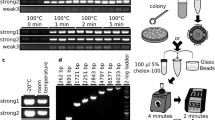Abstract
Simple, rapid, and efficient techniques of DNA isolation from a wide range of organisms are currently in demand in biotechnology and bioinformatics. Cell-wall destruction, as well as the subsequent DNA extraction from the disintegrated cells, is key (and often limiting) step. We have developed a new approach to DNA isolation from organisms with robust cell walls. The protocol includes the following steps: the treatment of cells or tissue samples with ammonium acetate, followed by cell lysis in low-salt buffer with added SDS. Further DNA extraction is carried out according to standard methods. This approach is efficient for the isolation of large amounts of high-molecular native DNA from bacteria, ascomycetes, yeasts, and mammalian blood; it is also useful for the express analysis of environmental microbial isolates and for plasmid extraction in two-hybrid library screening.

Similar content being viewed by others
REFERENCES
Sambrook, J., Molecular Cloning: A Laboratory Manual, Russell, D., Ed., Cold Spring Harbour Laboratory Press, 2001, vol. 1, 2, 3.
Ausubel, F., Short Protocols in Molecular Biology, New York, N.Y.: Wiley, 1997.
Hughes, D.E. and Nyborg, W.L., Cell disruption by ultrasound, Science, 1962, vol. 138, p. 108. https://doi.org/10.1126/science.138.3537.108
Roh, C., Villatte, F., Kim, B.G., and Schmid, R.D., Comparative study of methods for extraction and purification of environmental DNA from soil and sludge samples, Appl. Biochem. Biotechnol., 2006, vol. 134, no. 2, pp. 97–112. https://doi.org/10.1385/abab:134:2:97
Griffiths, L.J., Anyim, M., Doffman, S.R., et al., Comparison of DNA extraction methods for Aspergillus fumigates using real-time PCR, J. Med. Microbiol., 2006, vol. 55, no. 9, pp. 1187–1191. https://doi.org/10.1099/jmm.0.46510-0
Elsner, H. and Lindblad, E., Ultrasonic degradation of DNA, DNA (Mary Ann Liebert, Inc.), 1989, vol. 8, no. 10, pp. 697–701. https://doi.org/10.1089/dna.1989.8.697
Tighe, S., Afshinnekoo, E., and Rock, T.M., Genomic methods and microbiological technologies for profiling novel and extreme environments for the Extreme Microbiome Project (XMP), J. Biomol. Tech., 2017, vol. 28, no. 1, pp. 31–39. https://doi.org/10.7171/jbt.17-2801-004
Sahin, F., K?yan M., Karasartova D., et al. A new method for the disruption of cell walls of gram-positive bacteria and mycobacteria on the point of nucleic acid extraction: sand method, Mikrobiyol. Bul., 2016, vol. 50, no. 1, pp. 34–43. https://doi.org/10.5578/mb.10685
Murray, J.M., Watson, A.T., and Carr, A.M., Extraction of chromosomal DNA from Schizosaccharomyces pombe, Cold Spring Harb. Protoc., 2016, vol. 2016, no. 5. https://doi.org/10.1101/pdb.prot090985
Dyer, D. and Iandolo, E., Rapid isolation of DNA from Staphylococcus aureus, Appl. Environ. Microbiol., 1983, vol. 46, no. 1, pp. 283–285. https://doi.org/10.1128/AEM.46.1.283-285.1983
Lippke, J.A., Strzempko, M.N., Raia, F.F., et al., Isolation of intact high-molecular-weight DNA by using guanidine isothiocyanate, Appl. Environ. Microbiol., 1987, vol. 53, no. 10, pp. 2588–2589. https://doi.org/10.1128/AEM.53.10.2588-2589.1987
Oshiro, S., Katsura, N., Kitada, K., and Gunge, N., A simple method for extraction of DNA from fungi and yeasts with anhydrous hydrogen fluoride, FEBS Lett., 1987, vol. 220, no. 2, pp. 383–386. https://doi.org/10.1016/0014-5793(87)80851-7
VKPM Catalogue. http://vkpm.genetika.ru/katalogmikroorganizmov/.
VKM Catalogue. http://www.vkm.ru/rus/Catalogue. htm.
James, P., Halladay, J., and Craig, E., Genomic libraries and a host strain designed for highly efficient two-hybrid selection in yeast, Genetics, 1996, vol. 144, no. 4, pp. 1425–1436.
Singh, U.A., Kumari, M., and Iyengar, S., Method for improving the quality of genomic DNA obtained from minute quantities of tissue and blood samples using Chelex 100 resin, Biol. Proced. Online, 2018, p. 20. https://doi.org/10.1186/s12575-018-0077-6
Li, B.J., Li, H.L., Shi, Y.X., and Xie, X.W., First report of Pseudomonas cichorii causing leaf spot of vegetable sponge gourd in China, Plant Dis., 2014, vol. 98, no. 1, p. 153. https://doi.org/10.1094/PDIS-03-13-0312-PDN
Riera-Ruiz, C., Vargas, J., Cedeno, C., et al., First report of Burkholderia glumae causing bacterial panicle blight on rice in Ecuador, Plant Dis., 2014, vol. 98, no. 7, p. 988. https://doi.org/10.1094/PDIS-10-13-1024-PDN
Ritchie, R. and Gibson, J., Permeability of ammonia and amines in Rhodobacter sphaeroides and Bacillus firmus, Arch. Biochem. Biophys., 1987, vol. 258, no. 2, pp. 332–341. https://doi.org/10.1016/0003-9861(87)90352-3
Klocke, R., Ritchie, R., and Gibson, J., Permeability of ammonia and amines in Rhodobacter sphaeroides and Bacillus firmus, Arch. Biochem. Biophys., 1987, vol. 258, no. 2, pp. 332–341.
Andersson, K., Rotman, H., and Forster, R., Permeability of human erythrocytes to ammonia and weak acids, Am. J. Physiol., 1972, vol. 222, no. 4, pp. 1004–1013. https://doi.org/10.1152/ajplegacy.1972.222.4.1004
Antonenko, Y., Pohl, P., and Denisov, G., Permeation of ammonia across bilayer lipid membranes studied by ammonium ion selective microelectrodes, Biophys. J., 1997, vol. 72, no. 5, pp. 2187–2195. https://doi.org/10.1016/S0006-3495(97)78862-3
Dellaporta, S., Wood, J., and Hicks, B., A plant DNA minipreparation: version II, Plant Mol. Biol. Rep., 1983, vol. 14, no. 1, pp. 19–21. https://doi.org/10.1007/BF02712670
Moller, E., Bahnweg, G., Sandermann, H., and Geiger, H., A simple and efficient protocol for isolation of high molecular weight DNA from filamentous fungi, fruit bodies, and infected plant tissues, Nucleic Acids Res., 1992, vol. 20, no. 22, pp. 6115–6116. https://doi.org/10.1093/nar/20.22.6115
Funding
This study was financially supported by the Kurchatov Genomic Center of the Kurchatov Institute National Resource Center (GOSNIIGENETIKA).
Author information
Authors and Affiliations
Corresponding authors
Ethics declarations
The authors declare that they have no conflicts of interest.
This article does not contain any studies involving animals performed by any of the authors.
This article does not contain any studies involving human participants performed by any of the authors.
Additional information
Abbreviations: CCCP—carbonyl cyanide m-chlorophenylhydrazone; EDTA—ethylenediaminetetraacetate; GuHCl—guanidine chloride; HF—hydrofluoric acid; PCR—polymerase chain reaction; rRNA—ribosomal RNA; SDS—sodium dodecyl sulfate; TE buffer—EDTA solution in Tris buffer; VKM—All-Russian Collection of Microorganisms; VKPM—All-Russia Collection of Industrial Microorganisms.
Rights and permissions
About this article
Cite this article
Sidoruk, K.V., Levitin, E.I., Sviridov, B.V. et al. A Method of DNA Extraction from a Wide Range of Objects via Treatment with Ammonium Salts. Appl Biochem Microbiol 57, 899–906 (2021). https://doi.org/10.1134/S0003683821080056
Received:
Revised:
Accepted:
Published:
Issue Date:
DOI: https://doi.org/10.1134/S0003683821080056




